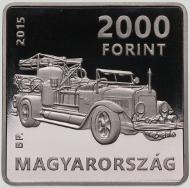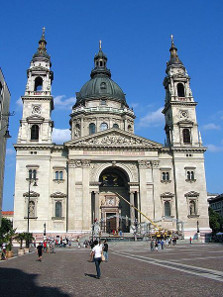August 20, 2015 – The Magyar Nemzeti Bank has issued a collector coin celebrating the 125th anniversary of the birth of Kornél Szilvay, one of the greatest figures in the history of Hungarian firefighting and technology. The 2000 Forint copper alloy collector coin is the tenth issue in the series celebrating Hungarian engineers and inventors, and their innovations and inventions.
Hungary / 2000 Forint / 2015 / Cupro-Nickel / 14 g / 28.43 mm / Designer: Balázs Bitó / Mintage: 4,000 BU and 6,000 Proof.
The obverse of the square-shaped coin bears a representation of the all-purpose fire extinguisher patented by Kornél Szilvay. The value numeral and the inscription ‘FORINT’ are positioned in two horizontal lines below each other on the upper right edge, with the inscription ‘MAGYARORSZÁG’ positioned along the lower edge. The mint year ‘2015’ and the mint mark ‘BP’ are positioned on the left edge, parallel with the rim and above the fire extinguisher.
The reverse bears a portrait of Kornél Szilvay surrounded by a frame, with the initials of designer Balázs Bitó in the lower left corner. The coin inscribed with ‘SZILVAY KORNÉL’ on the upper edge, ’A SZÁRAZOLTÁS ATYJA’ on the right, parallel with the rim, and with ‘1890 – 1957’ on the lower right and, parallel with the rim, ‘TÜZOLTÓPARANCSNOK’.
Thanks to the invention of Kornél Szilvay, the fire in the Saint Stephen’s Basilica in Budapest in 1947 was extinguished without water damage. Photograph: Wikipedia / Attila Terbócs. https://creativecommons.org/licenses/by-sa/3.0/deed.de
Kornél Szilvay was one of the greatest figures in the history of Hungarian firefighting and technology, temporary head of the Budapest municipal fire brigade after World War II. He was born on 25 July 1890 in Budapest. His father was a printer, junior railway official and later a maintenance man at the Schlick Vagon- és Gépgyár. His keen interest in technology came from both from his father’s influence and the development of Hungary’s mechanical engineering industry. After finishing school, he was awarded a degree as a technician from the engineering faculty of the Budapest Industrial College. He became deeply interested in firefighting after participating in a firefighting drill during his school-days.
After completing his studies, he became the plant firefighter at the Schlick factory and later joined the Budapest Volunteer Firefighters Association. His first successful innovation was solving the ignition problems with the motor of a Margirus pumper truck. From 1914 he was a professional firefighter, first as a technical officer and later as senior officer. He quickly recognised the shortcomings of fixed hose firefighting. He considered it very important to keep firefighters safe and to preserve property. He focused specifically on modernising firefighting equipment and developing sensible procedures.
In 1923, he patented his invention, a fire extinguisher using an inert gas. Two of these extinguishers were added to the firefighting trucks and proved extremely effective in extinguishing small fires, with little collateral damage. The essence was that the exhaust gases from an internal combustion engine were cooled and pressurised by a compressor, and this gas was used to blow the extinguishing powder (soda bicarbonate) onto the fire. The fire extinguishing powder has a smothering effect: it forms a melted layer on the burning surface, and prevents re-ignition as an oxygen-excluding, heat insulating crust.
In 1925, the production of the first dry fire extinguishers started at the MÁVAG Mozdony- és Gépgyár factory. The system was used successfully on its very first call when a fire broke out in the Gobelin hall of the National Casino, it was possible to repair all of the property affected. The equipment was officially added to the firefighting system in 1928. This Hungarian invention was a hit at the international firefighting exhibition held in 1929 in Paris and received wide acclaim in the press. The four dry firefighting units were used to supress 95 fires in Budapest, with excellent success.
During his career, Szilvay took part in putting out thousands of fires. One of the highlights was extinguishing the fire in the cupola of the Budapest cathedral on 20 June 1947 without any water damage. He also held patents for many other inventions such as a valve closing in reaction to heat, a swimming pump, fire and explosion-proof cabinets, and the “alarmograph” fire alarm system.
All in all, Kornél Szilvay had 39 patents, but it is mainly the method of extinguishing flammable liquid and electrical fires with which his name is associated. He fell victim to the political intrigues in the early 1950s, but was later rehabilitated and retired in 1957, after 43 years of service. He died on 8 September 1957, leaving a rich legacy as one of Hungary’s most outstanding inventors and fire chiefs.
Learn more about the Magyar Nemzeti Bank on the official website.
The history of fire fighting is illustrated in the Eger Museum of Fire Fighting.
And here you can find a list of museums of fire fighting all around the world.







